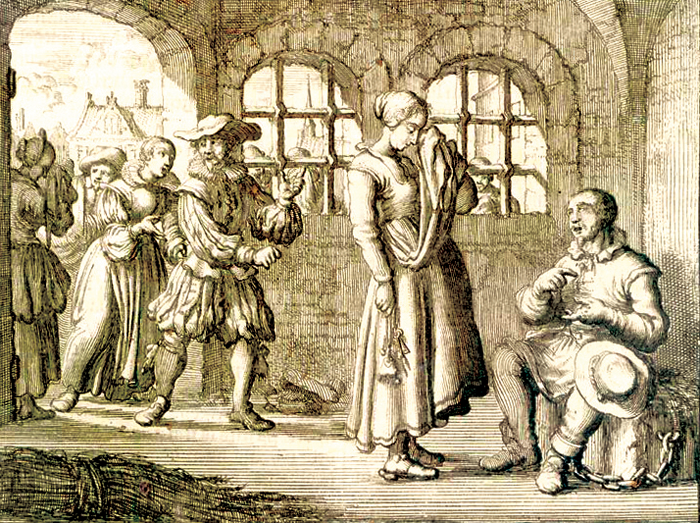Jacques D’Auchy was a highly-educated Dutch martyr, whose argumentation before his inquisitor constitutes an important confession for understanding the development of Mennonite theology and belief in the 1500s.
Despite D’Auchy’s compelling testimony, however, the Jan Luyken engraving that accompanies D’Auchy’s story in the Martyrs Mirror is not focused on him, but on his wife and her grief. (The original plate, previously thought to be lost, was recently acquired by the Martyrs Mirror Trust.)

The Martyrs Mirror account of D’Auchy reports that those who witnessed the farewell between the couple were moved and “most heartily wept with her.” The quality and steadfastness of her faith are also briefly mentioned a number of times in the account.
Other than those few passages, however, the narrative is focused on D’Auchy and on his conversations with the inquisitor.
Yet Luyken’s artistic rendering prods us to identify with D’Auchy’s wife, not with D’Auchy himself.
Many of the stories that appear on the Bearing Witness site could be similarly re-framed. For example, although the stories of Jacob Wipf and the Hofer brothers, Andreas Wurtz, David Klassen, and Black Kettle are mostly focused on the actions and experiences of men, they all also mention women who were involved.
The Hutterite wives of Joseph, Michael, and David Hofer and Jacob Wipf left their small children at home and travelled to Fort Leavenworth to find their husbands. Maria Hofer, married to Joseph, pushed past military guards and demanded that she be allowed to see her husband’s body, after he died from his treatment.
Margarethe Wurtz left the Catholic Church with her husband and fled with her family across the Carpathian Mountains. Her youngest child was three at the time, but women with younger children had to nurse them while crossing the mountain range on foot, so that the babies would not cry and attract the attention of the police.
For a year and a half after their crossing, Margarethe and the other mothers cooked, cleaned, and created homes for their families in simple dugout earth shelters on the outskirts of Bucharest.
David Klassen’s sister, Margarethe, spent her adult years teaching and visiting the poor and sick, until she died while caring for family members with typhus. She declined any marriage opportunities and considered her teaching and ministry work her faith vocation.
Together David and his wife, Sara, adopted a girl whose parents had been deported from their home in Ukraine for being kulaks and took in Sara’s parents when they returned from exile. Sara herself spent eleven years in the Karaganda labor camp in Kazakhstan, and she managed their home in Karaganda when David was imprisoned in the 1960s.
Black Kettle’s wife, Medicine Woman, accompanied her husband in numerous peace processes with the United State government, even as peace became increasingly elusive. She suffered bullet wounds at the Sand Creek Massacre and later died along with Black Kettle at the Washita Massacre on November 27, 1868.
These stories were written to highlight the experiences and testimonies of men, yet they also involve women and clearly contain inspiring examples of female perseverance in faith despite suffering.
While a full one-third of the testimonies that appear in Martyrs Mirror are about women, other martyr stories in the Anabaptist traditions have often heavily featured men, who were more likely to have been visible and sanctioned church leaders.
In some ways, peace traditions are even more susceptible to a predominantly male focus because war resistance has historically been expressed as resistance to conscription. Since militaries conscript men, the stories of war resistance that get passed down are similarly selective.
And yet women’s stories are there for the telling, if we’re willing ask different questions and redefine our categories of “suffering” and “resistance.” Luyken’s illustration of D’Auchy’s story, for example, makes me wonder how his wife continued in her faith and practice after he was gone; about her experience of giving birth and caring for an infant as a widow; about how she told the story of D’Auchy to her children.
Scholars have begun to do some of this work. Historian Rachel Waltner Goossen, for example, researched the stories of women who voluntarily chose to serve as conscientious objectors in World War II, even though they were never conscripted by the military.
This is not just scholars’ work, however, but rather a task for all of us who consider stories of costly discipleship to be formative, including artists like Luyken. He didn’t know D’Auchy’s wife’s story, but he noticed her presence and began asking questions.
We can start by asking questions of the stories that are part of the Bearing Witness Stories Project and by noticing the presence of women of faith, even in the stories that, at first glance, seem to be primarily about men. And, of course, Bearing Witness especially welcomes story submissions that seek to tell the stories of costly discipleship from the perspective of women themselves!